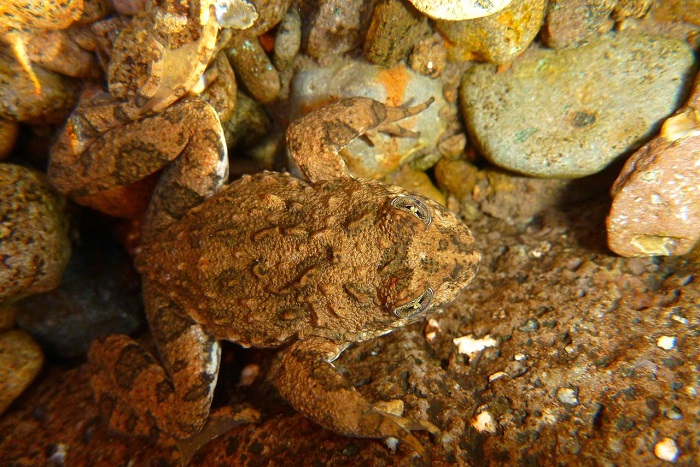View the above photo record (by Michael Cunningham) in FrogMAP here.
Find the Phofung River Frog in the FBIS database (Freshwater Biodiversity Information System) here.
Family Pyxicephalidae
PHOFUNG RIVER FROG – Amietia hymenopus
(Boulenger, 1920)
Habitat
A. hymenopus inhabits Alti Mountain Grassland vegetation, in topography characterized by steep slopes and fast-flowing streams. Annual precipitation is 500–750 mm and occurs as summer thunderstorms and winter snowfalls. Adults forage in grassland on the plateaux and on gentle slopes. When breeding, they may be found in seepage areas, along the rocky banks of gently flowing streams, or near the edges of pools.

Photo by Michael Cunningham
Behaviour
Breeding occurs after the first spring rains in September, through to January. Unlike other members of this genus, A. hymenopus lays its eggs in the water. Clutches of 200–500 eggs are attached to rock in flowing water or deposited in shallow, stagnant pools at the sides of streams. Eggs may also be laid in many smaller batches of 7–15 (Channing 1979). The development of the tadpoles has not been documented.
Status and Conservation
A. hymenopus occupies uplands that are generally free of impacts that would affect it negatively. The species occurs in the uKhahlamba-Drakensberg Park. It is not believed to be threatened, and no special conservation action is recommended. However, the number of atlas records for this species is very limited and it is recommended that additional surveys be conducted to determine the true extent of the species’ range and the size of its populations. The presence of chitrid fungus infections in Ametia vertebralis (see species account), a species that inhabits the same uplands, indicates that Amietia hymenopus should also be monitored for this pathogen. Little is known of the life history of A. hymenopus and this also handicaps conservation assessment.

Photo by Dieter Kassier
Distribution
A. hymenopus is endemic to the high slopes of the Drakensberg and Lesotho highlands. The southernmost record from Barkley East (3027DC) appears isolated, but this is probably due to inadequate sampling. The species occurs at altitudes of 1800–>3000 m.
Very few records were collected during the atlas period. The atlas data are reliable but incomplete.
Further Resources
Virtual Museum (FrogMAP > Search VM > By Scientific or Common Name)
More common names: Phofung-rivierpadda (Afrikaans)
Recommended citation format for this species text:
Tippett RM. Phofung River Frog Amietia hymenopus. BDI, Cape Town.
Available online at http://thebdi.org/2022/03/27/phofung-river-frog-amietia-hymenopus/
Recommended citation format:
This species text has been updated and expanded from the text in the
2004 frog atlas. The reference to the text and the book are as follows:
Bates MF 2004 Amietia hymenopus Phofung River Frog. In Minter LR
et al 2004.
Minter LR, Burger M, Harrison JA, Braack HH, Bishop PJ, Kloepfer D (eds)
2004. Atlas and Red Data Book of the Frogs of South Africa, Lesotho and
Swaziland. Smithsonian Institution, Washington, and Avian Demography
Unit, Cape Town.

